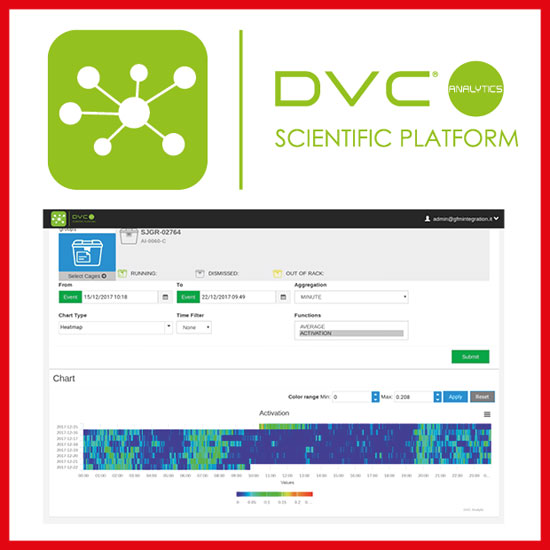

Automated recordings of laboratory animals’ home cage behavior are receiving increasing attention since such non-intruding surveillance may aid an unbiased understanding of the normal animal cage behavior and may improve animal experimental reproducibility. You might agree that there are several available scientific tools in the field providing different benefits and promising revolutionary results. However, all of them share the same common initial weakness introducing unwanted and uncontrolled variability: animals must be moved outside their standard environment (the IVC cage) in order to be deeply analyzed in specifically designed tools (sometimes cages).
Moreover, this aspect represents also a second clear weakness due to the limited sample size because economically (and physically) one cannot afford to proceed with several dozen items of equipment in parallel. Accordingly, the final outcome of the experiment must consider these aspects and consider the appropriate number of animals to reduce this variability, affecting the time and the economic aspects of the study itself and vice versa.
Last year, Tecniplast launched an innovative electronic and software infrastructure, called DVC® system. This system has been designed to provide many different benefits to the users from a Facility management perspective with different modules fitting different needs. What is now emphasized is, the same DVC® system also enables a complementary module mainly designed for researchers to enhance experiment outcomes and improving reproducibility.
In more detail, the DVC® board, which is the electronic core of the entire DVC® system, collects valuable locomotor animal activity directly from the real home cage (Tecniplast IVC GM500 cage), because it is firmly attached to standard IVC racks (Tecniplast DVC® racks) just under the cage itself.
Thanks to the DVC® system, the researcher can automatically collect data that can explain and show animal activity from his/her cages, 24/7, especially during the night when animals are supposed to better express their phenotype/behavior and obviously without moving animals outside the cage itself (reducing stress and so possibly confounding factors).
In order to make the best use from these DVC® raw data generated by any DVC® board in the field, Tecniplast designed and developed a specific cloud-based portal called DVC® Analytics. This portal can be easily accessed through internet from any web-enabled device allowing researchers and lab managers to have a deeper look inside the active and completed experiments providing complementary animal locomotor activity coming directly and automatically from their home-cages.
More technically, the DVC® raw data are meaningless if no proper metrics (i.e. functions) are applied to extract valuable animal activity information.
Furthermore, it is fundamental to associate and correlate this information with real events coming from the management of the cage itself (a cage change task for instance that induces higher animal activity). This is an extremely fundamental information item that cannot be skipped at all in any analysis of the experiment due to its inducing external variability that can affect final outcome and repeatability of the experiment itself.
The currently implemented and available metrics are:
AVERAGE - It provides the average of the raw data for each electrode of the corresponding DVC® board. It can be used to, e.g.:
ACTIVATIONS - Measures activity within the cage by capturing animal movements. It can be used to, e.g.:
The current metadata (events) generated by the DVC® system and pushed real time to the DVC® Analytics platform are:
The DVC® Analytics implements and offers different available charts and graphics to visualize the corresponding information to speed up the analysis, as well as helping to easily group cages together for more comparison analysis between groups (cross-sectional study, i.e. experimental vs control) and/or the same group in different time intervals (longitudinal studies). In addition, there is also a very powerful feature, called Near Real Time, able to provide (near) real time animal activity data displayed by a specific graph coming from selected cages. This functionality can be easily applied to experiments where the researcher wants to see if animals are recovering from a specific surgery/situation or are quickly affected in the locomotor activity by a specific provided compound/task.
In conclusion, thanks to the DVC® Analytics platform, users can get the most from their installed DVC® system and complement their experiments with locomotor animal activities directly from true home-cages without disturbing the animals and drastically increasing the potential sample size as the DVC® can be naturally embedded into standard IVC Racks.
For more scientific information, you can start discovering how other researchers have already used the DVC® system:
Effect of Environmental Enrichment on Aggression in BALB/cJ and BALB/cByJ Mice Monitored by Using an Automated System (Giles, Jareca M; Whitaker, Julia W; Moy, Sheryl S; Fletcher, Craig A)
https://www.ingentaconnect.com/content/aalas/jaalas/2018/00000057/00000003/art00003
Food and water restriction lead to differential learning behaviors in a head-fixed two-choice visual discrimination task for mice (Pieter M. Goltstein, Sandra Reinert, Annet Glas, Tobias Bonhoeffer, Mark Hübener)
https://journals.plos.org/plosone/article?id=10.1371/journal.pone.0204066
Giorgio ROSATI – Digilab Marketing Manager